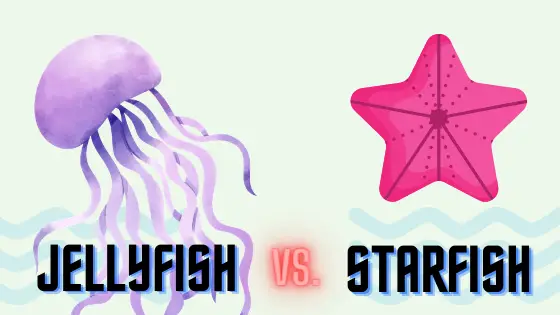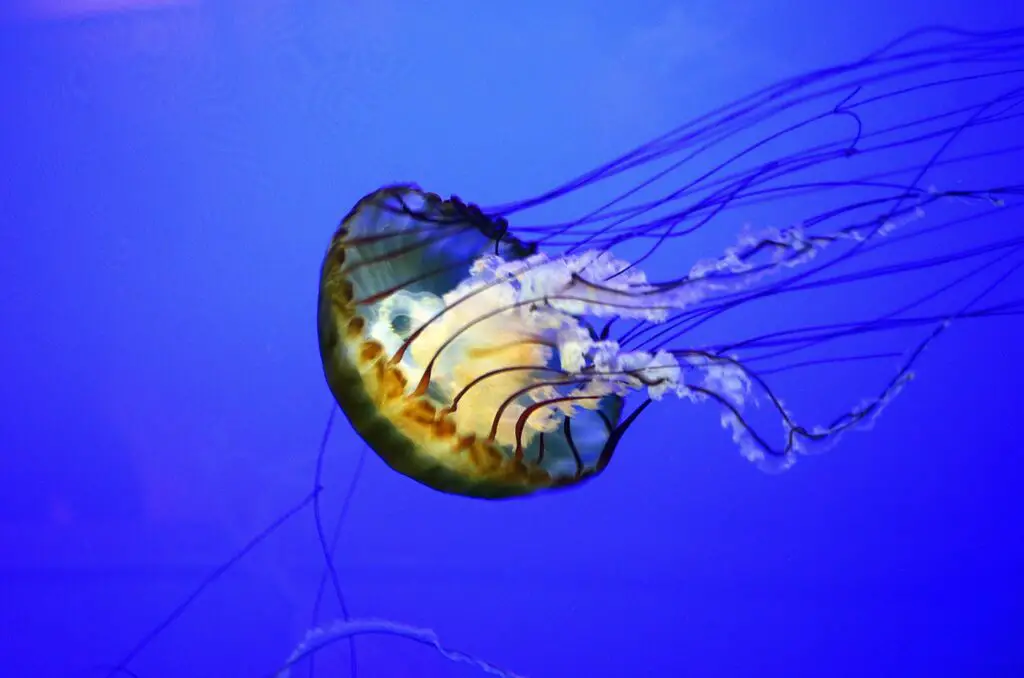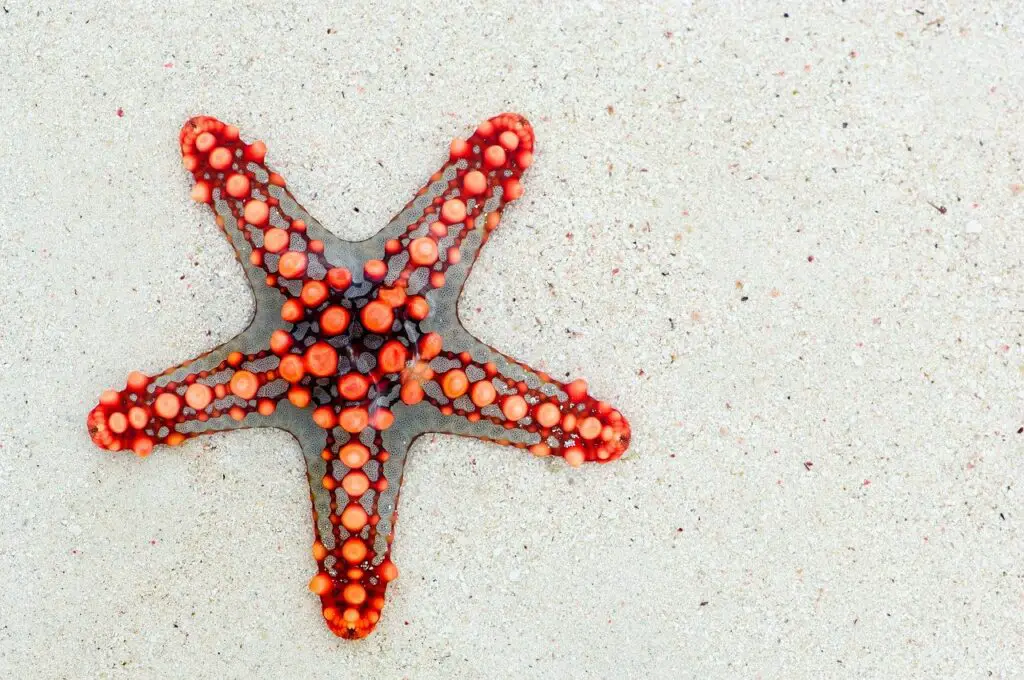Difference Between Jellyfish and Starfish
In this post, we will know about the key differences between Jellyfish and Starfish.
After reading this post, you can perfectly differentiate a Jellyfish from a Starfish and vice-versa.
↓↓↓↓↓↓
The main difference between Jellyfish and Starfish is that Jellyfish falls under Phylum Coelenterata (lower invertebrates), and Starfish falls under Phylum Echinodermata (higher invertebrates). Jellyfishes have tissue level of body organization whereas, Starfishes have very simple organ system level of body organization.
Well! There’re a lot of differences between Jellyfish and Starfish. They both are two different organisms from the two different phyla with very few common characters.
Moreover, there’s also a very often asked query. Are Jellyfish and Starfish similar to Fishes?
NO! Jellyfish and Starfish are not fishes. They are a lot different from the fishes.
A Jellyfish is a marine aquatic animal that has an umbrella like upper body part that have tentacles with stinging cells attached to it. Most species are extremely small, but some have tentacles up to 100 feet.
Jellyfishes are usually soft, gelatinous jelly-like, mostly transparent, and smooth in appearance due to the presence of 95% water in the body.
A Starfish is also a marine aquatic animal that has a very dry body with its outer surface made up of calcium carbonate components. They look mostly star like in appearance and can have anywhere between 5 to 50 arms depending on the species.
Starfishes are usually a bit hard, with a rough appearance due to the presence of a skeleton made of calcium carbonate plates. Their body is solid with a spiny upper surface composed of various colours and designs.

Comparison Chart: Jellyfish Vs. Starfish
| DIFFERENCE BASED UPON PROPERTIES | JELLYFISH | STARFISH |
|---|---|---|
| CLASSIFICATION |
Phylum: Coelenterata Class: Scyphozoa |
Phylum: Echinodermata Class: Asteroidea |
| BODY |
Body is gelatin type (jelly-like) and transparent, made up of 95% of water. |
Body is made up of Calcium carbonate components called ossicles. |
|
Jellyfishes are Radially symmetrical |
Adults are Radially symmetrical. Larvae are Bilaterally symmetrical. |
|
|
The reddish or pinkish gonads are clearly visible through the transparent body. |
They aren’t transparent so no inner body parts can be visible |
|
| They follow the tissue level of body organization. | They follow a simple organ system level of body organization. | |
| LOCOMOTION | They have the upper umbrella-shaped body with tentacles below them that helps them move. | They can have 5 to 50 limbs with tube feet in them to adhere and move. |
| Jellyfish moves with a simple jet propulsion system. It contracts its bell to create pressure in the water below. That pressure force propels it forward. | They move using a water vascular system. Water comes into the system via. the madreporite. It is then circulated in the body providing suction to the tube feet. | |
| NUTRITION | Jellyfish have tiny stinging cells in their tentacles with which they kill their prey. They then put their prey inside their mouth located in the bell-shaped upper body. | Mouth lies on the underside of the body and they feed on mussels, clams, small fish, etc. |
| No proper digestive system present. Food is directly broken down by the digestive enzymes produced by cells lining the inner body cavity. | Have a proper Digestive system. Starfish have a unique digestive system with a mouth at the center of their underside body and an anus on their upper surface. | |
| HABITAT | They are marine and aquatic and can be found in every ocean in the world. | They are also marine and aquatic and can be seen in every ocean and sea. |
| Jellyfish can be found in shallow waters near the coastline or in the middle waters deep out in the open sea. | Starfish usually stay on the ocean floor or cling to rocks near the shore, but occasionally float on the top of the water. | |
| LIFE CYCLE | Jellyfish have a polyp phase when they are attached to coastal reefs, and a medusa phase when they float among the plankton. | The larvae pass through two developmental stages before settling down on the ocean floor and becoming mature adults. |
| REPRODUCTION | Jellyfish reproduce both sexually and asexually. | Starfish can also reproduce sexually and asexually. |
| Here, one generation (the medusa) reproduces sexually and the next generation (the polyp) reproduces asexually. | Asexual reproduction in starfish takes place by fission or through autotomy (regeneration) of arms. Sexual reproduction takes place when fertilization occurs in the water with males and females releasing sperm and eggs. |

Definition of Jellyfish
Jellyfishes are animals that belong to the class Scyphozoa of phylum Coelenterata.
They are lower invertebrates having a tissue level of body organization.
These are basically very simple organisms with a thin layer of skin and a primitive digestive system.
In this class, the life cycle of Jellyfish shows Medusa stage which is the dominant and conspicuous zooid. While, the polypoid form is the short larval stage.
Jellyfish have a soft and transparent body which is composed of 95% water and so they can perfectly camouflage inside water.
A jellyfish has no head, ears, eyes, nose, brain, and heart. Their body is jelly-like and totally made of water. Their body has no bones and is really very very soft.
They do have a mouth. The mouth of the Jellyfish is found in the centre of its body.
The body of a jellyfish has radial symmetry. The body is divided into three main parts: the umbrella, the oral arms (around the mouth), and the stinging tentacles.
They have stinging cells in each of their tentacles. These tentacles contain venom that kills their prey, as it is well seen that they use their tentacles to capture prey and defend against predators.
Jellyfish have a complex life cycle. The medusa stage is normally the sexual phase while, the planula stage is the larval stage that can disperse widely and is followed by a sedentary polyp phase.
These are free-swimming and are always under the mercy of the water currents that take them from place to place. They can just move up and down with the help of the tentacles which provide them the direction of movement.
They usually float and remain on the top surface of the water. It’s all due to the water currents.
They mainly feed on phytoplankton, zooplankton, small crustaceans, very small fishes, and even on other jellyfishes.

Definition of Starfish
Starfishes are aquatic animals that belong to the Class Asteroidea of Phylum Echinodermata.
These are marine higher invertebrates that display pentamerous radial symmetry of the body and an exoskeleton of calcareous plates and spines.
Their larval stage is bilaterally symmetrical while the adult stage is radially symmetrical.
Starfishes are also termed as sea stars and these are commonly observed in rocky tide pools. They mainly occur on sandy or muddy buttons of the sea or crawl about over rocks or shells of other molluscs.
They can be highly witnessed in the sandy beaches when they get washed up onto the shores of all of the world’s oceans.
They are well represented in almost all seas from tide-marks to deep waters. They move slowly on hard substratum with the help of their characteristic locomotory podia or tube feet. Starfish can move at a rate of 20 feet per hour.
They also have the capability to regenerate their lost arms. And moreover, they can have anywhere between 5 (most commonly) to 50 arms depending on the species.
They are carnivores in nature. They mainly feed on phytoplankton and zooplankton trapped in mucus secreted by their body and carried to their mouth by cilia.
The cilia are present in the stomach which usually comes out of its mouth and attaches over the digestible parts of its prey to pulls it inside the mouth. They excrete through their tube feet.
The starfish is born in the form of larvae, and once they break off from the egg, they start their maritime life, where they remain larvae until they are five years old.
At the age of 5 years, they finally become adults, with a life expectancy which ranges between ten and thirty years.
They don’t have eyes, brain, or any central nervous system.
What they do have is an exoskeleton made of calcium carbonate plates and a complex nervous system with one sensory tentacle at the end of each arm.
Another noteworthy thing is that, Starfishes have seawater (instead of blood) which is actually used to pump nutrients through their bodies via. a water vascular system.
Key Differences Between Jellyfish and Starfish
1. Jellyfishes have only a tissue system level of body organization whereas, Starfishes have a very simple organ system level of body organization.
2. Jellyfish has a transparent and soft body whereas, Starfish has an opaque body with hard Calcium Carbonate exoskeleton.
3. Jellyfish has tentacles for movement whereas, Starfish has 5 to 50 arms with tube feet for movement.
4. Jellyfishes are Radially symmetrical. Whereas in Starfishes, Adults are Radially symmetrical while Larvae are Bilaterally symmetrical.
5. Jellyfish do not have a specialized digestive system, osmoregulatory system, central nervous system, respiratory system, or circulatory system. Starfish have a specialized digestive system, unique water vascular system, well-equipped Haemel and Perihaemel circulatory system, a reproductive system, and a partially developed respiratory and nervous system.
6. Jellyfish catches prey using their venomous stings in their tentacles, killing it, and then taking it inside through the mouth. Whereas, Starfish catches prey by extending its stomach to take the prey inside the mouth.
7. Most jellyfishes are short-lived. Some jellyfish species can live for 2-3 years as well. On the other hand, Starfishes reaches its maturity in five years and has a maximum recorded lifespan of about 34 years.
8. Jellyfish do not have eyes, and so their nervous system can sense or smell the surroundings with the help of water currents. Starfish have eyes using which they are able to detect different shades of light thus allowing them to navigate their surroundings. Starfish have eyes, one on the end of each of their arms, meaning that in the majority of the cases the number of eyes is equal to the number of arms.
Conclusion
Although both Jellyfish and Starfish may be a lot different but, their presence can’t be ignored. They are included in the list of some of the most important organisms that can maintain the ocean ecosystem a lot.
Jellyfishes are food for a number of marine animals such as large fish and turtles. Even humans eat jellyfish.
Jellyfishes can also protect the small fishes from being eaten by predators with their stinging cells. They do also take a huge part in the food web and food chain of the ocean ecosystem.
Talking about the starfishes, it is well profound to say that the starfish are the awesome predators, and they’re probably the most important predator in the shallow ecosystem of the oceans.
The Starfishes eat basically anything that they can come across. Their feeding activities control the whole ecosystem by maintaining the balance in the food web and food chain.
